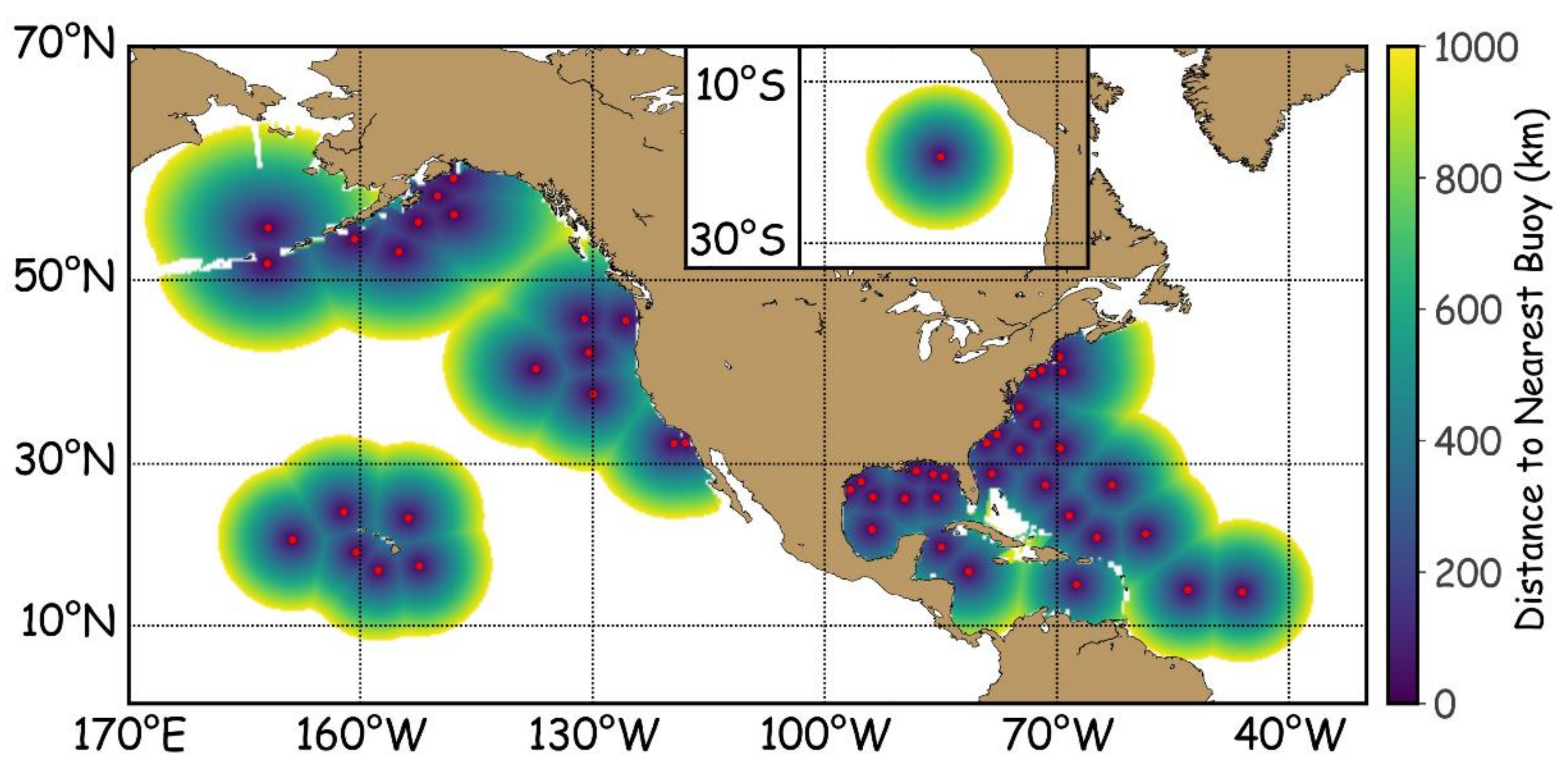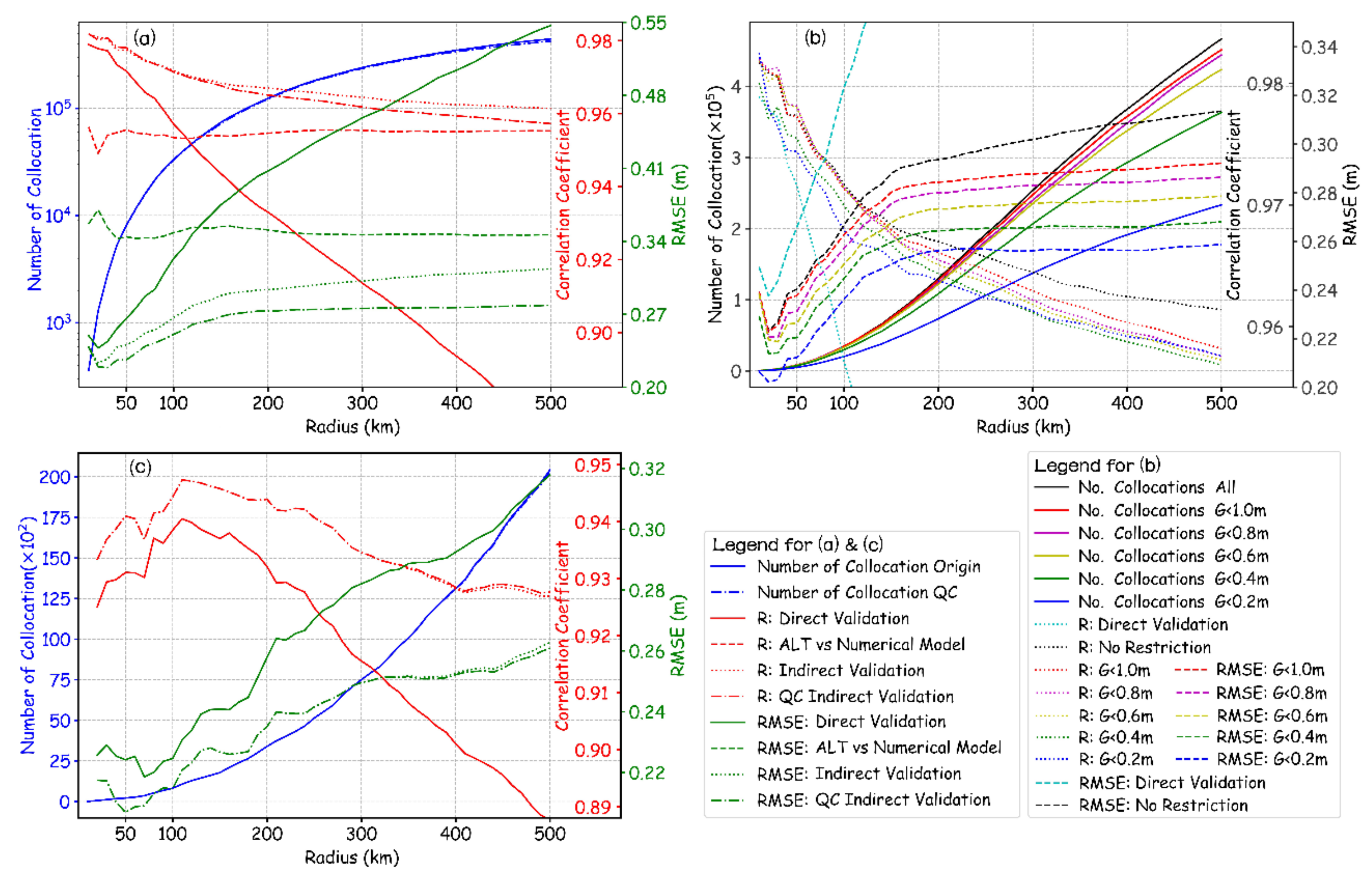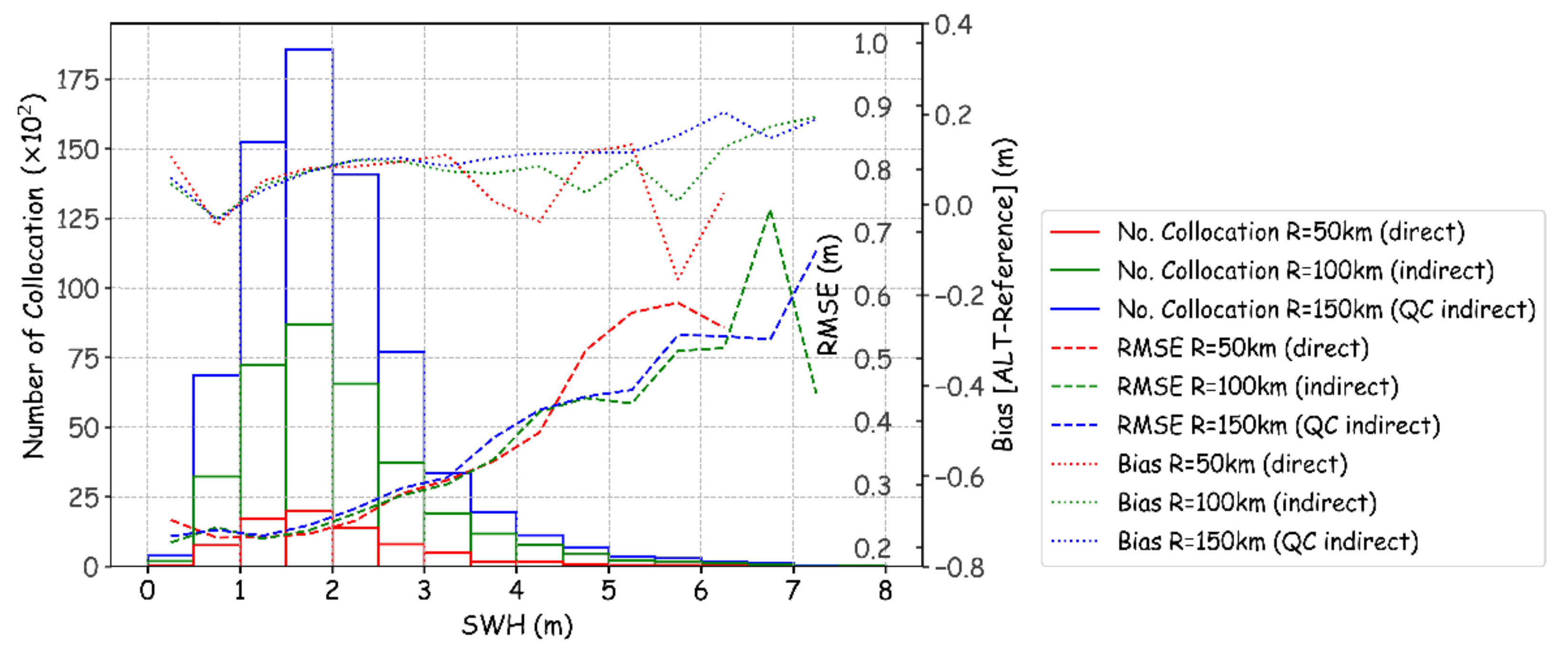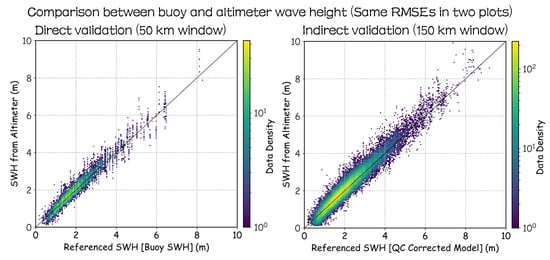Indirect Validation of Ocean Remote Sensing Data via Numerical Model: An Example of Wave Heights from Altimeter
Abstract
1. Introduction
2. Data and Methods
2.1. Data
2.1.1. Altimeter Data
2.1.2. Buoy Observations
2.1.3. Numerical Wave Model Outputs
2.2. Methods
2.2.1. Direct/Indirect in Situ Validation
2.2.2. Direct/Indirect Cross-validation
3. Results
3.1. Direct/Indirect in Situ Validation
3.2. Direct/Indirect Cross Validation
4. Discussion and Conclusions
Funding
Acknowledgments
Conflicts of Interest
Appendix A
| Buoy ID | Latitude | Longitude | Buoy ID | Latitude | Longitude | Buoy ID | Latitude | Longitude |
|---|---|---|---|---|---|---|---|---|
| 32012 | 19.425°S | 85.078°W | 42019 | 27.907°N | 95.352°W | 46006 | 40.782°N | 137.397°W |
| 41001 | 34.625°N | 72.617°W | 42020 | 26.968°N | 96.694°W | 46047 | 32.398°N | 119.498°W |
| 41002 | 31.76°N | 74.84°W | 42036 | 28.501°N | 84.516°W | 46059 | 38.072°N | 129.966°W |
| 41004 | 32.501°N | 79.099°W | 42039 | 28.788°N | 86.008°W | 46066 | 52.785°N | 155.047°W |
| 41010 | 28.884°N | 78.45°W | 42040 | 29.208°N | 88.226°W | 46072 | 51.656°N | 172.058°W |
| 41013 | 33.436°N | 77.743°W | 42055 | 22.12°N | 93.96°W | 46073 | 55.031°N | 172.001°W |
| 41040 | 14.559°N | 53.073°W | 42056 | 19.918°N | 84.938°W | 46076 | 59.502°N | 147.99°W |
| 41041 | 14.329°N | 46.082°W | 42057 | 16.908°N | 81.422°W | 46078 | 55.556°N | 152.582°W |
| 41043 | 21.132°N | 64.856°W | 42059 | 15.252°N | 67.51°W | 46080 | 57.947°N | 150.042°W |
| 41044 | 21.575°N | 58.625°W | 44008 | 40.504°N | 69.248°W | 46086 | 32.491°N | 118.035°W |
| 41046 | 23.832°N | 68.417°W | 44014 | 36.611°N | 74.843°W | 46089 | 45.925°N | 125.771°W |
| 41047 | 27.52°N | 71.53°W | 44017 | 40.694°N | 72.048°W | 51000 | 23.538°N | 153.808°W |
| 41048 | 31.86°N | 69.59°W | 44018 | 42.119°N | 69.7°W | 51001 | 20.849°N | 168.798°W |
| 41049 | 27.537°N | 62.945°W | 44025 | 40.251°N | 73.164°W | 51002 | 17.037°N | 157.696°W |
| 42001 | 25.897°N | 89.668°W | 46001 | 56.232°N | 147.949°W | 51003 | 19.289°N | 160.569°W |
| 42002 | 26.091°N | 93.758°W | 46002 | 42.612°N | 130.537°W | 51004 | 17.602°N | 152.395°W |
| 42003 | 26.007°N | 85.648°W | 46005 | 46.14°N | 131.07°W | 51101 | 24.318°N | 162.231°W |
References
- Steele, K.E.; Mettlach, T.R. NDBC wave data - current and planned. In Proceedings of the Ocean Wave Measurement and Analysis - Proceedings of the Second International Symposium, New Orleans, LA, USA, 25–28 July 1993; pp. 198–207. [Google Scholar]
- Monaldo, F. Expected differences between buoy and radar altimeter estimates of wind speed and significant wave height and their implications on buoy-altimeter comparisons. J. Geophys. Res. Ocean. 1988, 93, 2285–2302. [Google Scholar] [CrossRef]
- Ribal, A.; Young, I.R. 33 years of globally calibrated wave height and wind speed data based on altimeter observations. Sci. Data 2019, 6, 77. [Google Scholar] [CrossRef] [PubMed]
- Liu, Q.; Babanin, A.V.; Guan, C.; Zieger, S.; Sun, J.; Jia, Y. Calibration and Validation of HY-2 Altimeter Wave Height. J. Atmos. Ocean. Technol. 2016, 1, 919–936. [Google Scholar] [CrossRef]
- Zhang, H.; Wu, Q.; Chen, G. Validation of HY-2A Remotely Sensed Wave Heights against Buoy Data and Jason-2 Altimeter Measurements. J. Atmos. Ocean. Technol. 2015, 2, 1270–1280. [Google Scholar] [CrossRef]
- Durrant, T.H.; Greenslade, D.J.M.; Simmonds, I. Validation of Jason-1 and Envisat Remotely Sensed Wave Heights. J. Atmos. Ocean. Technol. 2009, 26, 123–134. [Google Scholar] [CrossRef]
- The WAVEWATCH III Development Group. User Manual and System Documentation of WAVEWATCH III version 5.16. 2016. Available online: https://polar.ncep.noaa.gov/waves/wavewatch/ (accessed on 16 June 2020).
- Ardhuin, F.; Rogers, E.; Babanin, A.V.; Filipot, J.-F.; Magne, R.; Roland, A.; van der Westhuysen, A.; Queffeulou, P.; Lefevre, J.-M.; Aouf, L.; et al. Semiempirical Dissipation Source Functions for Ocean Waves. Part I: Definition, Calibration, and Validation. J. Phys. Oceanogr. 2010, 40, 1917–1941. [Google Scholar] [CrossRef]
- Rascle, N.; Ardhuin, F. A global wave parameter database for geophysical applications. Part 2: Model validation with improved source term parameterization. Ocean Model. 2013, 70, 174–188. [Google Scholar] [CrossRef]
- Queffeulou, P.; Ardhuin, F.; Lefèvre, J.-M. Wave height measurements from altimeters: Validation status and applications. In Proceedings of the OSTST Meeting, Ocean Surface Topography Science Team, San Diego, CA, USA, 19–21 October 2011; pp. 19–21. [Google Scholar]
- Liu, Q.; Rogers, W.E.; Babanin, A.V.; Young, I.R.; Romero, L.; Zieger, S.; Qiao, F.; Guan, C. Observation-Based Source Terms in the Third-Generation Wave Model WAVEWATCH III: Updates and Verification. J. Phys. Oceanogr. 2018, 49, 489–517. [Google Scholar] [CrossRef]
- Cavaleri, L.; Alves, J.-H.G.M.; Ardhuin, F.; Babanin, A.; Banner, M.; Belibassakis, K.; Benoit, M.; Donelan, M.; Groeneweg, J.; Herbers, T.H.C.; et al. Wave modelling - The state of the art. Prog. Oceanogr. 2007, 75, 603–674. [Google Scholar] [CrossRef]
- Nencioli, F.; Quartly, G.D. Evaluation of Sentinel-3A Wave Height Observations Near the Coast of Southwest England. Remote Sens. 2019, 11, 2998. [Google Scholar] [CrossRef]
- Jiang, H.; Mu, L. Wave climate from spectra and its connections with local and remote wind climate. J. Phys. Oceanogr. 2019, 49, 543–559. [Google Scholar] [CrossRef]
- Stoffelen, A. Toward the true near-surface wind speed: Error modeling and calibration using triple collocation. J. Geophys. Res. Ocean. 1998, 103, 7755–7766. [Google Scholar] [CrossRef]
- Caires, S.; Sterl, A. Validation of ocean wind and wave data using triple collocation. J. Geophys. Res. Ocean. 2003, 108. [Google Scholar] [CrossRef]
- Hersbach, H.; Bell, B.; Berrisford, P.; Hirahara, S.; Horányi, A.; Muñoz-Sabater, J.; Nicolas, J.; Peubey, C.; Radu, R.; Schepers, D.; et al. The ERA5 global reanalysis. Q. J. R. Meteorol. Soc. 2020, 146, 1999–2049. [Google Scholar] [CrossRef]




© 2020 by the author. Licensee MDPI, Basel, Switzerland. This article is an open access article distributed under the terms and conditions of the Creative Commons Attribution (CC BY) license (http://creativecommons.org/licenses/by/4.0/).
Share and Cite
Jiang, H. Indirect Validation of Ocean Remote Sensing Data via Numerical Model: An Example of Wave Heights from Altimeter. Remote Sens. 2020, 12, 2627. https://doi.org/10.3390/rs12162627
Jiang H. Indirect Validation of Ocean Remote Sensing Data via Numerical Model: An Example of Wave Heights from Altimeter. Remote Sensing. 2020; 12(16):2627. https://doi.org/10.3390/rs12162627
Chicago/Turabian StyleJiang, Haoyu. 2020. "Indirect Validation of Ocean Remote Sensing Data via Numerical Model: An Example of Wave Heights from Altimeter" Remote Sensing 12, no. 16: 2627. https://doi.org/10.3390/rs12162627
APA StyleJiang, H. (2020). Indirect Validation of Ocean Remote Sensing Data via Numerical Model: An Example of Wave Heights from Altimeter. Remote Sensing, 12(16), 2627. https://doi.org/10.3390/rs12162627






